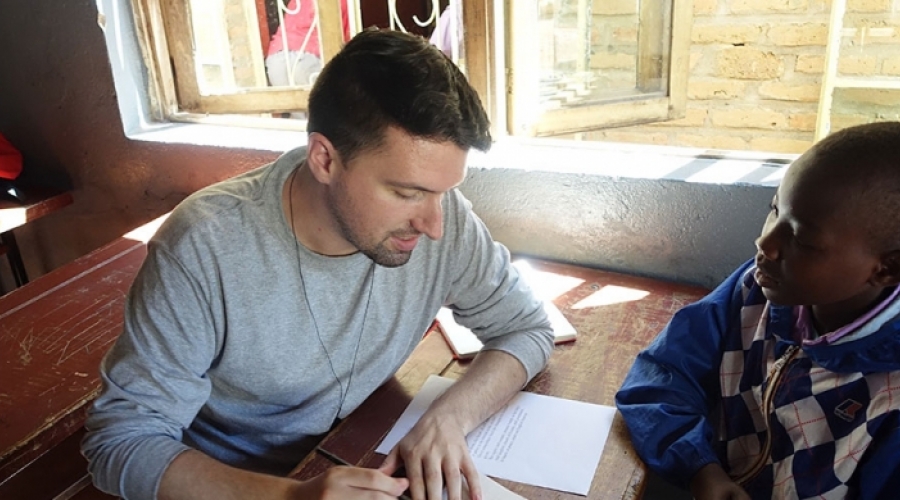
In this unique course, Otis students use multiple approaches and perspectives that address healthcare, questions of identity, diversity, and communication, along with their individual artistic/design practice, to create viable solutions for the community. View Part One.
Arriving in Malawi after 34 hours travel, the Otis group was led on a two-day orientation bus tour by Rich Shelton, director for Creative Action, and Luc Deschamps, Executive Director of Jacaranda. First on the agenda was to pay respects to Chief Chemboma on his small farm. He perched regally on a traditional carved wooden chair in his front yard, as the students encircled him. In English, he explained tribal structure and village governance. His duties included resolving conflicts between families, approving land deals and arranging marriages.
He praised Jacaranda as a great benefit to the village. “It’s a blessing, because I don’t know where I would put all the children who are orphans.” He underscored Da Silva’s appeal to the rest of the world that Malawi needs assistance digging itself out of poverty. “We need opportunities. We need solutions. We need to stand on our own. It is beautiful that all you people have decided to come here--it encourages us.”
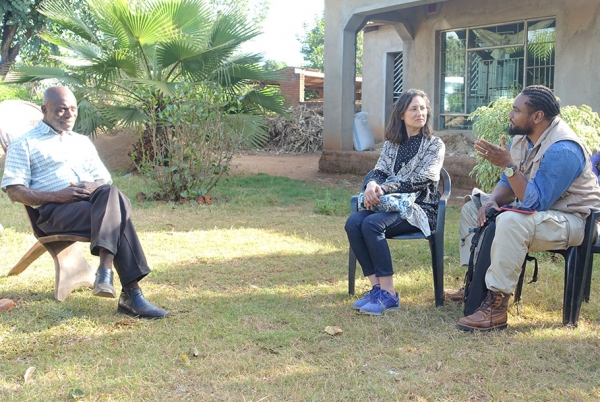
The tour was rounded out with a walk through an open-air local market; a glimpse of zebras and giraffes at a wildlife refuge; a visit to a history museum; a swing by a library established by Deschamps; and shopping for textiles at the Mapeto store, the company that makes the vibrantly colored fabric used for head wraps and chitenji, the wrap-around skirts worn by Malawian women.
Leave Good Things Behind
The Otis group was impressed by the Jacaranda kids’ curiosity and hunger for new experiences. Sophie was pleased when Clement and Ruben, two gifted Jacaranda juniors showed up at her fashion class. Having never been exposed to fashion, they began drawing and cutting out ensembles for female paper dolls. (After the Otis trip, Clement and Ruben were able to attend the Summer of Art program here in Los Angeles. Hear about their experience in the video below.)
The far edge of campus became a collaborative construction site. The kids helped Brandon and Wei cast chess pieces, experimenting with concrete textures. Nearby Kim and helpers drilled and painted an orange slat from which to hang green bottles, cans and old tools. “All you need is a saw and certain found objects,” said Kim. “The kids are so creative. Maybe I can get them thinking on a larger scale. Because they have large-scale trash.”
The idea was to ‘’leave good things behind”: not only objects, but techniques and props for activities the children could reproduce on their own. Yasamin organized “sports games” involving competitive wordplay and movement. “It’s fun and it doesn’t cost anything,” explained Yasamin. She also left behind used classic books for the library.
In his poetry writing class Jeff encouraged students to write about their personal losses. As some kids gripped pencils and stared at their paper, a solemn-faced 14-yr.-old boy named Chifukwa quickly filled a page in his notebook. Entitled “Never Blame the Young Boy,” Chifukwa’s poem included the lines, “Never blame the young boy who waited for his parents and saw nothing….The boy who was shivering from the cold and received no help, waiting for his death.” Jeff sat with Chifukwa, asked him questions about his life, and encouraged him to continue writing.
The Girls
When Skyping from Los Angeles, Monsy noticed the Jacaranda girls were less assertive than the boys. If they did speak up, they complained that domestic responsibilities drained their energy for schoolwork. “They say ‘we do the cleaning, we do the laundry, we do the cooking,’” said Monsy. “’It’s a privilege to be in the school, but when we come home we have to take care of the house.’ Especially if they have siblings, they are like working moms.”
Monsy proposed organizing a support group, which would be a safe space for them to air grievances and attempt to resolve them collectively. Da Silva agreed that it could be beneficial for the teen girls to open up to each other about shared issues such as career aspirations, family pressures and sexual abuse.

Monsy and Sylvie assembled the first “girls club” meeting where the Otis women read encouraging words from Eleanor Roosevelt and gently urged the Jacaranda teens to pursue their dreams. Monsy proposed the club be called “Kufunga,” which means blossom in Chechewa, and presented the girls with tote bags designed with a flower logo, as “incentives to motivate them.” A discussion was held about shared ideals to comprise the Kufunga “Manifesto.”
Few Jacaranda girls spoke but all agreed that Kufunga should meet on a monthly basis. “We will be helping each other,” enthused Tadala, a Kufunga member. “We are going to be safe and we are going to be strong women.”
Complex Emotions
At dinner each night, the Otis group compared notes on the day. Technical problems such as too crumbly cement were addressed. Mostly, burning impressions and feelings poured out. Impressed by the kids’ determination to lift themselves out of poverty through education, the Otis students were also daunted by the steep odds facing the Malawians. Opportunities for higher education and decent employment in their country were scarce.
The Otis group had reached a critical juncture. This was the transformative moment that is the objective of Creative Action, the payoff for the long trip to Malawi and all the work it took to get here. The Otis students had fallen in love with Jacaranda. They cared about the kids and their future, and caring had changed them. It meant committing to helping while recognizing the limitations of what they could do. They had grown.
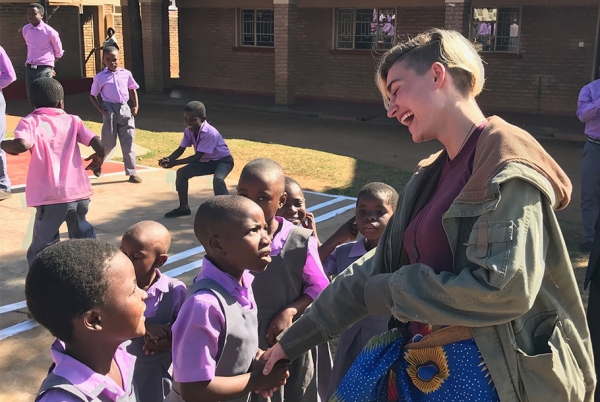
The last day was full of tearful goodbyes and promises to stay in touch. The Otis students put the final touches on projects, embedding the chessboard tiles under a Jacaranda tree. As Brandon and Deschamps discussed chessboard maintenance, Brandon shifted uncomfortably in a pair of too-small sneakers, wearing only exercise tights; he had swapped his cool boots with a student, and relinquished his pants.
Monsy, Sophie and the Kufunga girls gathered in an outdoor pavilion for an emotional goodbye. Yasamina tried to persuade Dorothy, Da Silva’s assistant and a Jacaranda graduate, to visit Los Angeles at the end of the summer. Tadala stated her ambition to come to Hollywood to work as a hair and make-up artist after graduation. The ambition and grit of the Jacaranda students was inspiring. “There is no excuse now, after seeing all that,” said Noah. “I’m taking their drive and hunger back home and applying it to my craft in Los Angeles.”
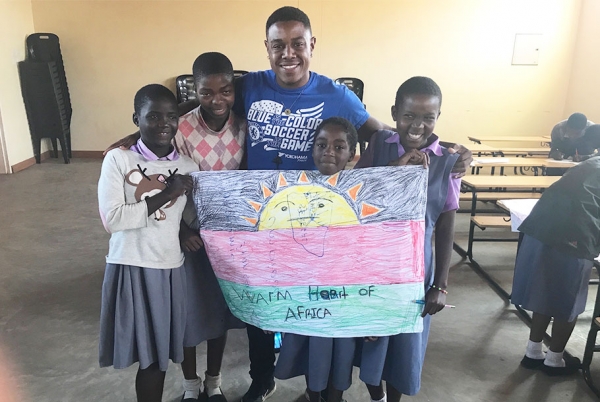
The entire school turned out for a lavish musical send-off to Otis. Accomplished self-taught performers, Jacaranda kids sang and danced, accompanying themselves on donated guitars and drums. Then Shelton took the stage, and thanked Da Silva and Deschamps. “We learned as much from you if not more than you learned from us,” he said.
Da Silva closed by applauding the Otis students for stirring the children’s imaginations. “Thank you for helping us identify their talents,” she said. “They don’t have parents to come tell us ‘my kid loves music.’ Thank you for being so easy and accommodating. Know that there is always a place for you at Jacaranda. We feel the love from you.”
Speaking with passion and her hand over her heart, she affirmed the power of a group of people journeying to a remote land to share their love of the arts. “Thank you, Otis, for opening your arms to Jacaranda, for encouraging these orphans. The results are perceptible. Right now these kids think they can do anything. They have so much confidence. They have dreams.”
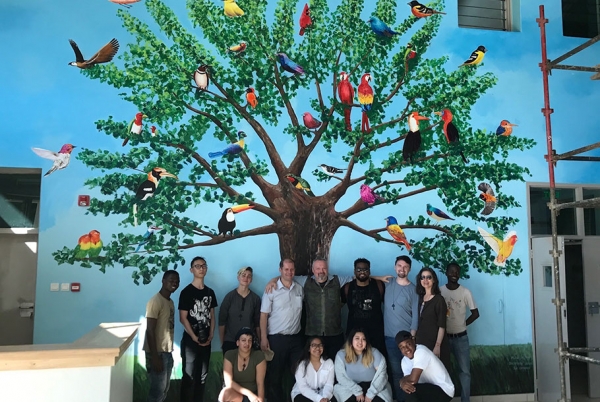
About Otis’s partnership with Jacaranda and the upcoming 2018 trip
First proposed by Otis graduate Rob Sussman, who believed that art education could improve the lives of these children, the project has grown from one class to a ten-year commitment from the College. Through the Creative Action and Liberal Arts and Sciences departments, the Made for Kids Malawi course allows both sets of students to develop a genuine relationship and understanding of each other prior to a 12-day cross-cultural exchange site visit to Malawi and the Jacaranda Foundation.
The Jacaranda Foundation is a perfect community partner for this approach since its mission has been to provide economic stability, a quality education, and reliable healthcare to children trying to manage their HIV positive status or maintain a normal life after being orphaned by AIDS.
Otis students have responded to this mission by doubling the number of students who have committed to this year’s class and trip. In 2018, students will be designing two murals for the school. Students will also create an outdoor game installation, design photography classes for the Jacaranda Photo Club, create several toy and doll-making workshops, and work with Jacaranda students to create outfits for a performance that highlights traditional dances and spoken word performances.
This is Part Two of our story on Creative Action's partnership with the Jacaranda School for Orphans. View Part One.
Students from Otis College and the Jacaranda Foundation will be hosting a live auction of their artwork on Sunday, April 22. All proceeds will support Otis and Jacaranda student expenses for upcoming trips. Learn more.


